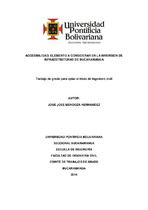Accesibilidad, elemento a considerar en la inversión de infraestructuras de Bucaramanga

View/
Date
2014-06Author
Mendoza Hernández, José José
xmlui.dri2xhtml.METS-1.0.item-advisor
Director. Salas Rondón, Miller Humberto
xmlui.dri2xhtml.METS-1.0.item-type
bachelorThesis
Citación
Metadata
Show full item recordDocuments PDF
Abstract
Con el incremento abrupto que se presenta en la adquisición de vehículos particulares, el mal uso que se le da al mismo (1,5 personas por vehículo promedio), la imprudencia de los conductores, la falta de cultura ciudadana y el mal estado de las vías; se tiene como resultado largos tiempos de viajes debido a los embotellamientos que se generan debido a estos factores que influyen en la vida cotidiana de las personas. En este trabajo se hicieron estudios de campo para cuantificar la gravedad del problema de movilidad que presenta la ciudad de Bucaramanga y su área metropolitana, para luego plasmar las redes (real y virtual) sobre grafos con la ayuda del software TransCAD con el cual se darán características propias a cada corredor vial existente y proyectado a futuro, y así poder calcular los tiempos de viajes para ir de un nodo a otro. La red real plasmada se hizo en base a la red existente tomando los principales corredores viales, por otro lado para la red virtual se tuvo en cuenta los proyectos previstos en el Plan Maestro de Movilidad de Bucaramanga tales como corredores e intersecciones. Las curvas isócronas son líneas que indican los puntos que se encuentran a igual cantidad de tiempo con respecto a un nodo indicado, estas curvas se dibujan utilizando los software TransCAD y SURFER 8, con el primero se obtiene el tiempo empleado para ir de un nodo a otro, estos tiempos son datos de entrada para que SURFER 8 dibuje las isócronas. Con estas curvas se visualiza el tiempo que ahorra una persona en su desplazamiento luego de hacer una inversión en infraestructura vial en Bucaramanga. Dicho cambio ayuda a mejorar la conectividad de las diferentes zonas del área metropolitana solucionando problemas de accesibilidad presentes debido a las pocas vías existentes. With the sharp increase that occurs in the acquisition of private vehicles, the misuse that is given to it (average 1.5 persons per vehicle), reckless drivers, lack of civic culture and the poor state of the streets, we have as a result long travel times due to traffic jams generated by these factors that affect the daily lives of people. In this work, field studies were made to quantify the severity of the problem of mobility presented in the city of Bucaramanga and its metropolitan area, and then to translate the (real and virtual) networks on graphs using the TransCAD software with which there will be specific characteristics given to each existing road corridor and proyected for the future, and so to calculate travel times to get from node i to node j. The real network was made based on the existing network taking the main road corridors. On the other hand, for the virtual network, the projects under the Plan Maestro de Movilidad de Bucaramanga such as corridors and intersections were taken into account. Isochronous curves are lines that indicate the points that are at equal time in regards to a specified node. These curves are drawn using the TransCAD and SURFER 8 softwares. With the TransCAD software, we obtain the time taken to travel from node i to node j. These times are the input so that the SURFER 8 software drawa the isochrones. With these curves, we can visualize the time that a person saves in its displacement after making an investment in road infrastructure in the city of Bucaramanga. This change helps improve the connectivity of the different zones or communes of the metropolitan area solving accessibility problems present due to the few existing roads.
Keyword/s
Ingeniería Civil
Software - Transcad
Curvas
Topología
Teoría de grafos
Collections
- Trabajos de grado [6440]
The following license files are associated with this item:

